
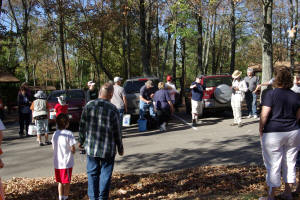
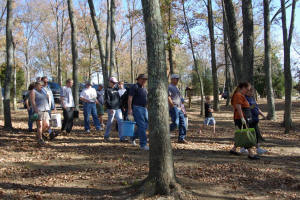


The Dry Dredgers had a beautiful day at the beginning of autumn 2010 for their September field rip. We returned to the long creek bed north of Cincinnati, Ohio, last visited in July of 2009. We first gathered at the picnic area and then proceeded down to the creek.
The creek exposed the Maysvillian Stage of the Cincinnatian Series of formations. Collecting fossils in creeks is widespread in the greater Cincinnati area. Looking for fossils in the creek bed is often the first fossil hunting experience a Cincinnatian child has.
With experience, the fossil hunter realizes that the sides of the creek are better for clean, perfect fossils. The bed of the creek is frequently polished by the water and stained by the algae and lichen. On the other hand, the creek sides have layers of rock where fossils in situ are weathering out. The creek sides are similar to road cuts in that respect.
In places along the creek walls there is clear
evidence that fossil collectors have been digging and breaking shale.

Creeks are excellent locations for digging whole trilobites such as Isotelus
and Flexicalymene. But responsible fossil hunters never dig in
public parks. It's possible to wander along creeks into private property.
Even when you have obtained permission to collect on private property, it's
often hard to tell whose property is whose and easily to stray away from your
own property when looking for fossils. We never dig into the creek walls without
obtaining permission from the land owner. Trespassing may be easily forgiven.
But for many people with land, digging is hard to forgive. So we are always
considerate.
As we meandered down the creek, we checked out the sides and
looked for freshly washed out trilobites and other great fossils.
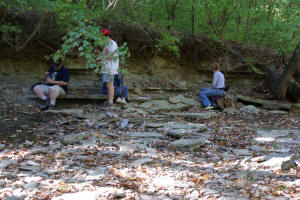
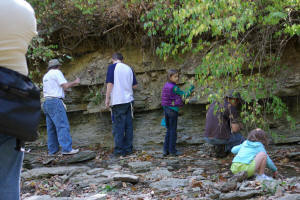
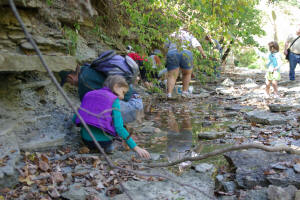
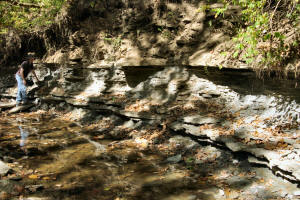
More experienced collectors pointed out some of the clues
that trilobites may be near.
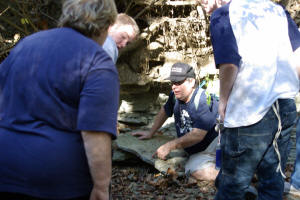
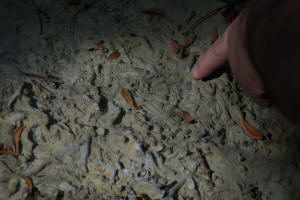
As you can see from the photos, all ages attend the field trips. Everyone has fun.
As we get further down the creek, the group thins out. It
turns into a great way to do your own thing and enjoy the scene around you.

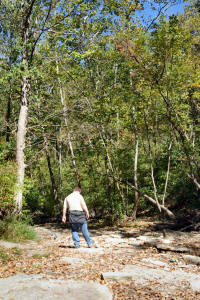
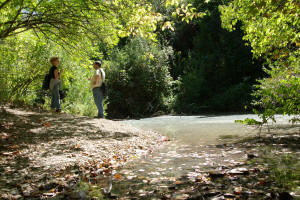
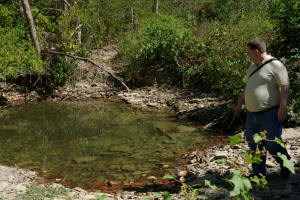
Fossils Found That Day (identifications to follow)
Yes. We did find trilobites. The best of which was this prone Flexicalymene.
The first of these two photos is an artistic approach to looking at a Flexi by
Cindy Striley, our membership chair.


The above trilobite will look great once it is professionally prepared.
Right now, it is covered with all kinds of things and is unwashed. Never wash
prone trilobites by submerging them in water or attempting to wash them in the
field. The plates of a prone trilobite flake off easily and the body is held
together by what may be water soluble material.
Lots of trilobite parts were found too. Here are some of them.


A Flexicalymene pygidium (tail)
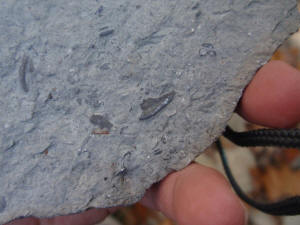
A Flexicalymene free cheek or genal area.

A Flexicalymene glabella and pygidium.
Cephalopods Found
I think the best Cephalopod found that day was a very long
siphuncle of a straight shelled nautiloid. Notice that the apparent chambers are
diagonal. This is one way to tell you've got a siphuncle. This one is on a rock,
but it's unusually long. Very nice find.
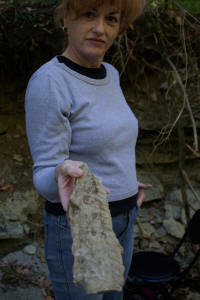

Most of the siphuncles appear as nothing more than a tube running down the chambers of straight shelled nautiloids. Note siphuncle in this next photo.
We find more casts of the outer chambers. Those chambers are
straight across.

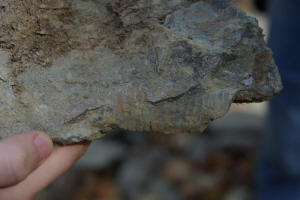


Check this next great specimen out. It's multiple Cephalopod
shells that rolled together on the ocean floor and are preserved as external
molds!
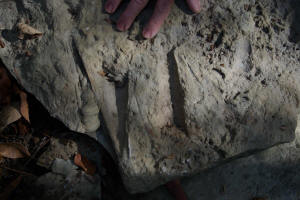
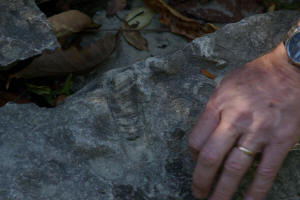


Sometimes we just find one or two chambers of the larger
cephalopods. That's what we have in the next two specimens.

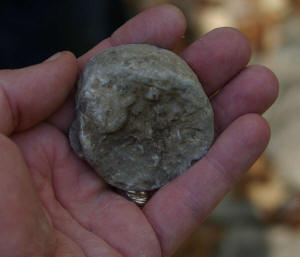
Brachiopods Found
Brachiopods can be exciting finds in a creek bed when they are
nicely preserved. A young DD member has found a beautiful brachiopod called Vinlandostrophia
ponderosa.
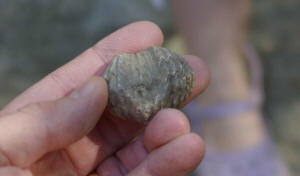



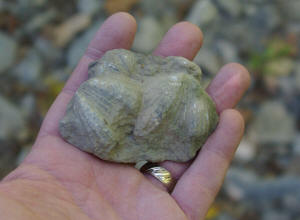
Bryozoans have encrusted the next specimen of P. ponderosa.
As we move up the creek we pass from the Bellevue Formation to
the Corryville Formation. This is evident by a unique species of the Brachiopod Rafinesquina
called R. nasuta. Mostly limited to the Corryville, R.
nasuta has a peak or "nose" at its margin, giving it a
slightly more triangular outline. (next 2 pics)


This next brachiopod, though, is a Rafinesquina
ponderosa, encrusted with bryozoans.

These Rafs are so common that they are found on almost all
rock surfaces.
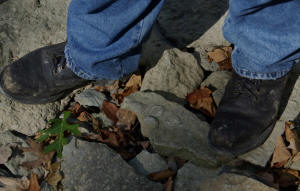
What is not common at all, and quite surprising to find are examples of the very delicate inarticulate brachiopod, Pseudolingula cincinnatiensis. This inarticulate brach lives under the mud, so it keeps company with clams. In the next 3 pics, it is found next to the bivalve Caritodens demissa.
This next specimen, is one of which I'm not sure. I think it's
also Pseudolingula cincinnatiensis, but the color is a bit dark.
It could be one of these clam bedfellows.
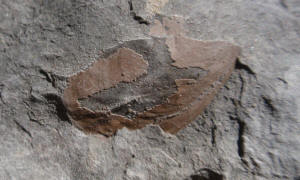
Bryozoans Found
Bryozoans are found abundantly throughout the Cincinnatian
Series of formations. However, identifying the species and often the genera
require comparing thin sections of the specimen to the documentation. This next
specimen is what we call a "leafy" bryozoan. It might be Heterotrypa
subfrondosa.
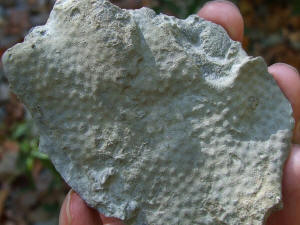

Another type of bryozoan we commonly find is the ramose or
"branching" bryo. Huge colonies of ramose bryozoans were found that
day on rocks and filled in with sediment. (next 2 pics)
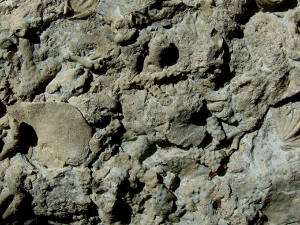
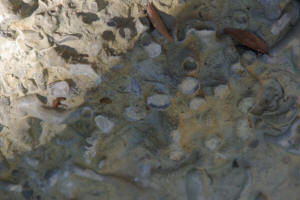
In creek beds, you will find bryozoans that are extremely worn
from water and exposure. One type of weathering is where you can see each zooid
chamber.

These weathered bryozoans litter the rock surfaces in creeks. If you see bones in the picture below, you owe it to yourself to join the Dry Dredgers and learn more about bryozoans.
Pelecypods (clams) Found
These first 3 photos are external molds of the clam Ambonychia.
Whereas other clams in the area have similar markings, Ambonychia
is by far the most common and there are a lot of species within this genera.
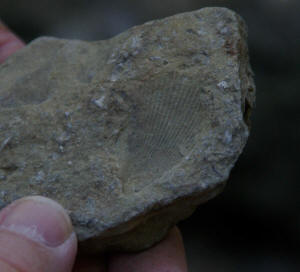


The next most common bivalve we found was Caritodens.
The specimen below is clearly Caritodens because of the shell
preservation. It also has "wings" that are missing in this specimen. Click
here for better photos of other Caritodens specimens.
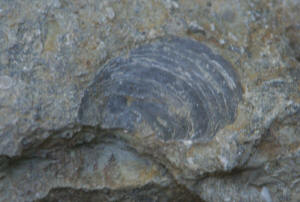
This next specimen could be Caritodens but is
also missing its "wings." If not, then it could be Modiolopsis.

In several cases, the clam specimens were found by cracking
open the shale layers weathering out of the creek banks. In these cases, both
the negative and he positive impressions of the clam shell are found. The photos
below are likely to be of the genus Modiolopsis.
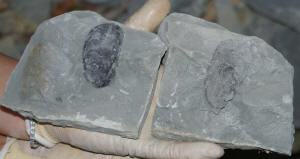
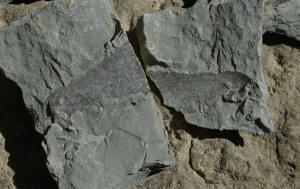
In some cases, we found 3-dimensional casts of clams. They
often show the hinge and the details of both valves.

Other clams were found on the surface of rocks.
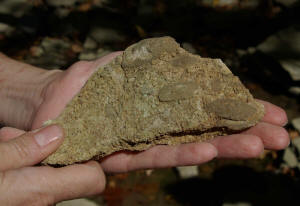

Trace Fossils
Trace fossils abounded on this site. This first example is a
worm burrow called Diplocraterian.
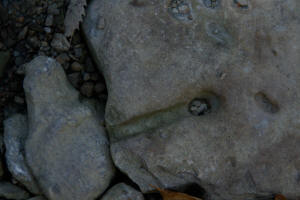
We encountered some mounds that were covered with trace
fossils. At first we thought they were the upside-down in-fills of indentations,
but there is evidence that these are indeed mounds.
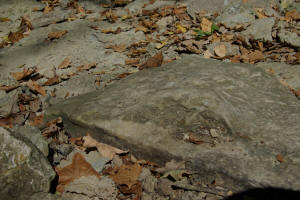
Lots of other trace fossils were found on the surface of
slabs.
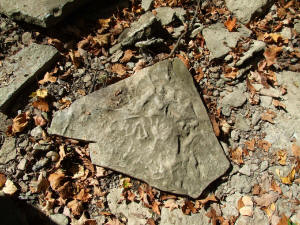

This interesting structure is probably not the traces of an
animal. It's more likely to be the marks of water between the layers of rock.
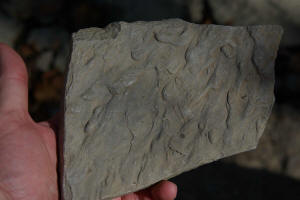
Gastropods and Monoplacophorans
We found a few Monoplacophorans of the variety Cyrtolites.

Among the gastropods, the most common and worth-keeping
specimens were Cyclonema.
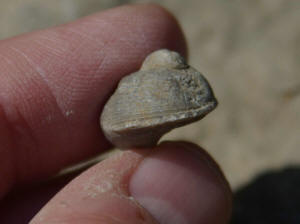
Crinoids Found
Not many crinoids were found except for some articulated stems
on rocks.

Non-Maysvillian Fauna
As was also true in the last trip to this site, we found some fossils that did not belong in the Maysvillian Stage of the Cincinnatian Upper Ordovician layers that are exposed at this site.
A few horn coral were found. These don't appear in the
Cincinnatian until you reach the Richmondian.

We also found oddities like this Spirifer brachiopod and coral
fragment.

And we saw some animals in the creek that resembled Ordovician
fossils but were not. For example, we often refer to an enrolled
Isotelus trilobite as a "Frog Head."
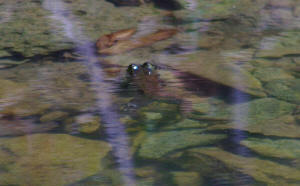
That's all for the September 2010 field trip. Hope you enjoyed it. This trip goes to show that even the less-desirable creek beds can turn up some interesting fossils and are very worth exploring.
Now lets look at the October 2010 trip to our favorite Northern Kentucky Byway
See previous trips to this creek bed site (2009)
Back to Field Trip Photo Index
Return to Dry Dredgers Home Page
The Dry Dredgers and individual contributors reserve the rights to all information, images, and content presented here. Permission to reproduce in any fashion, must be requested in writing to admin@drydredgers.org .